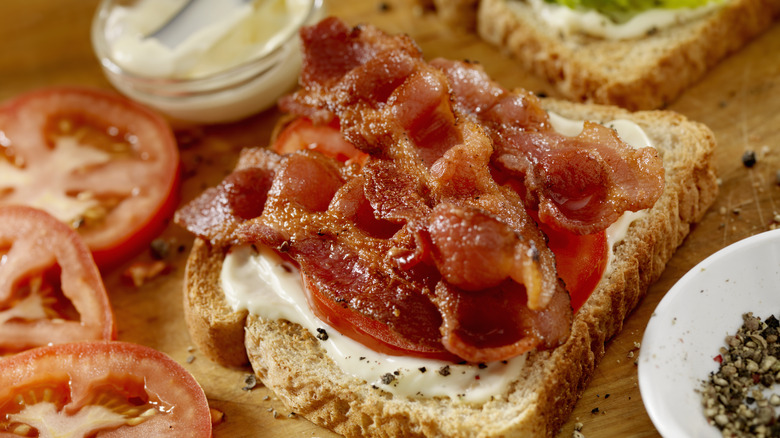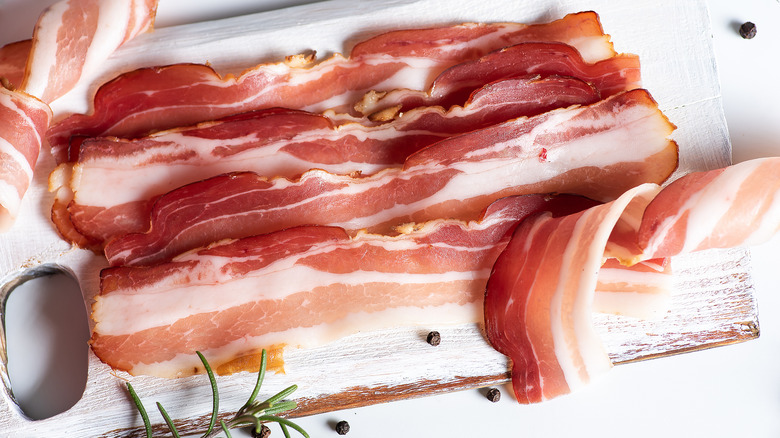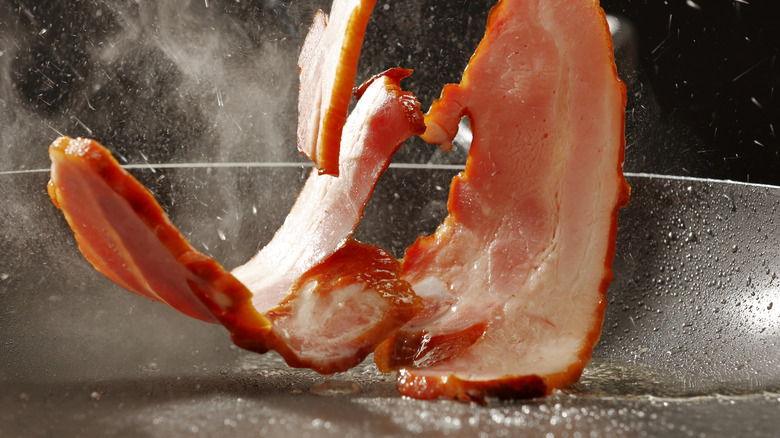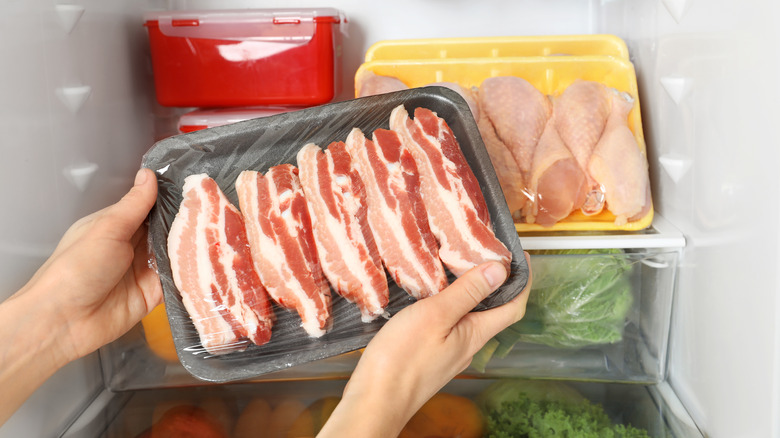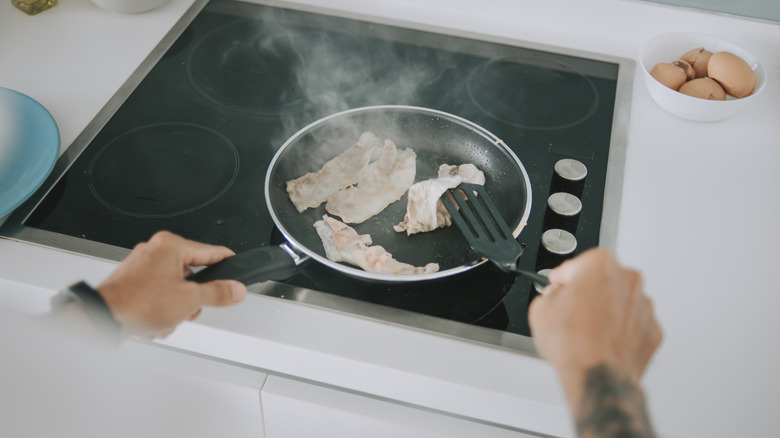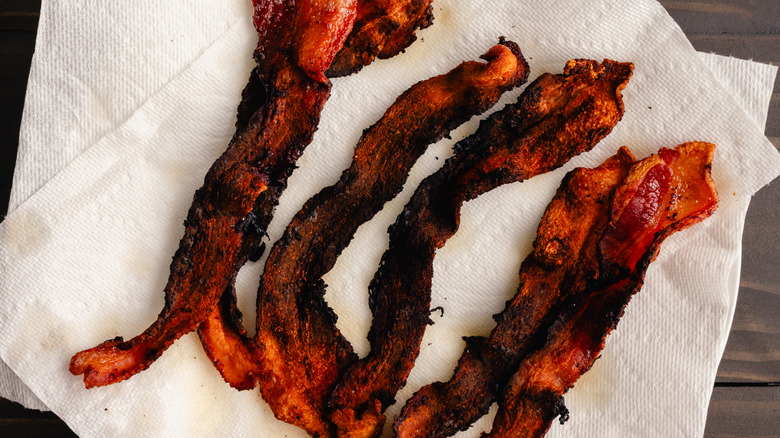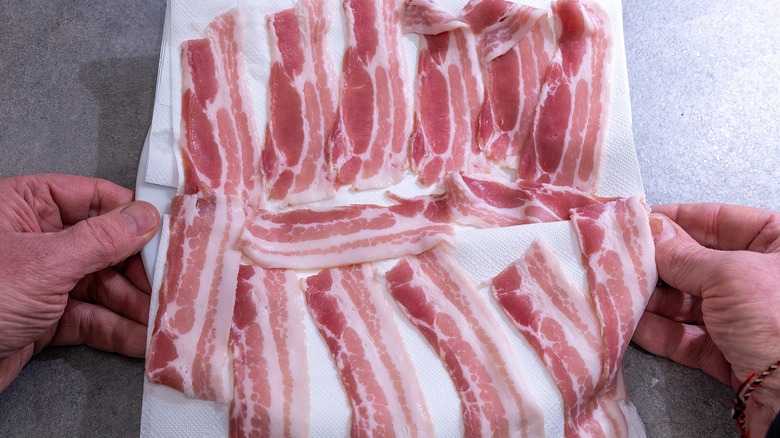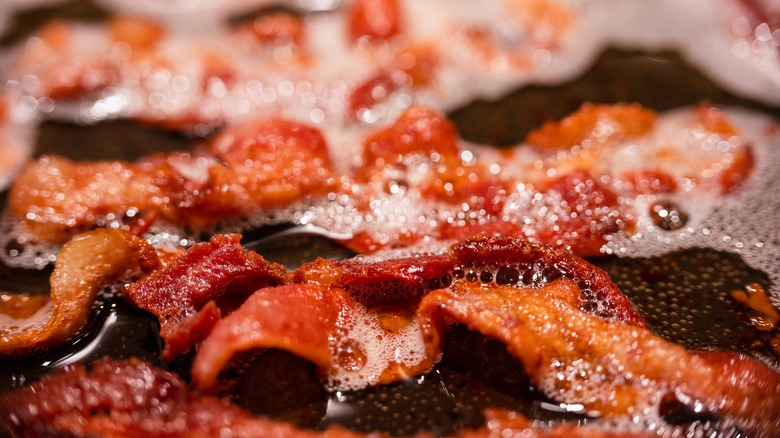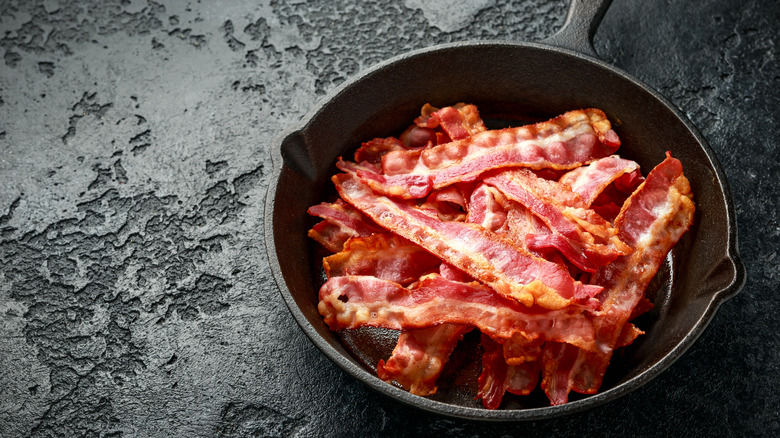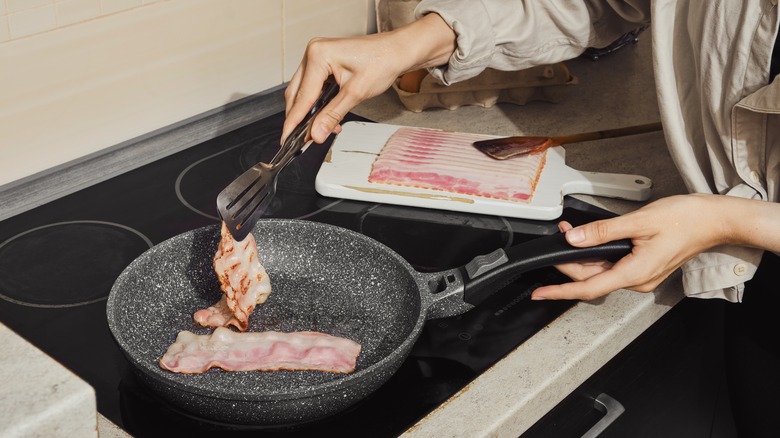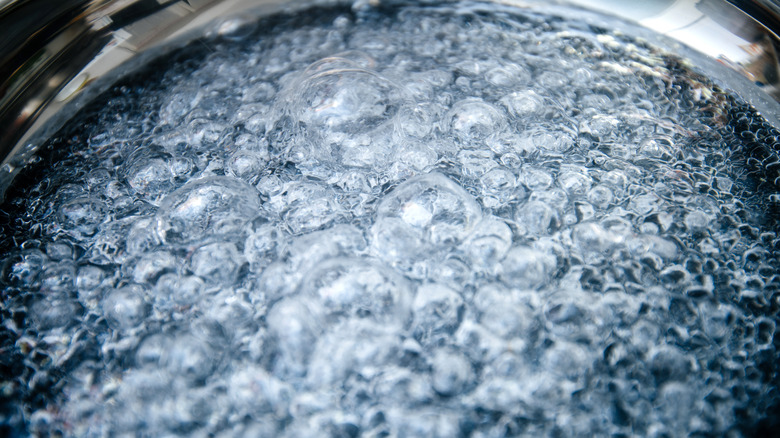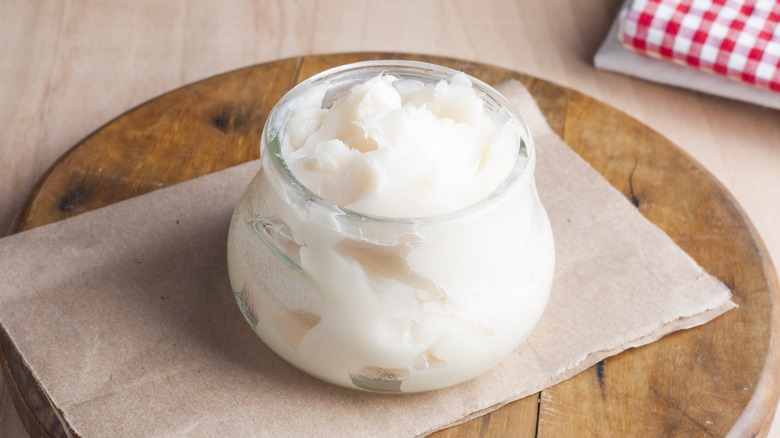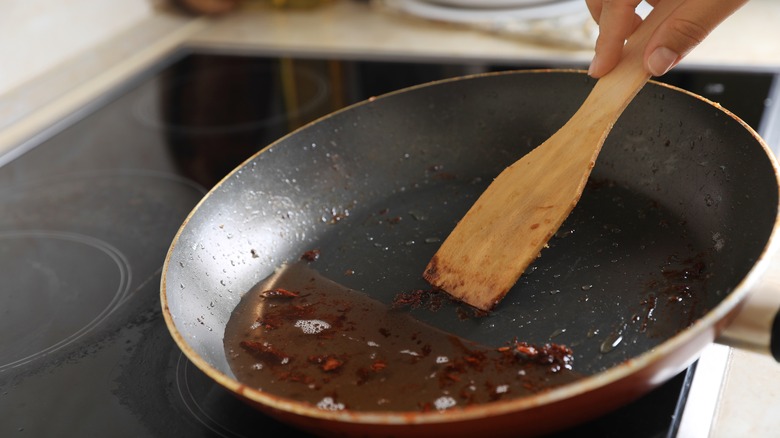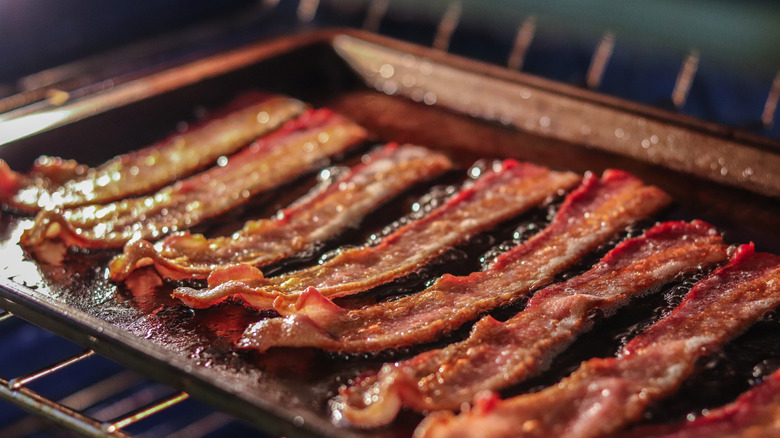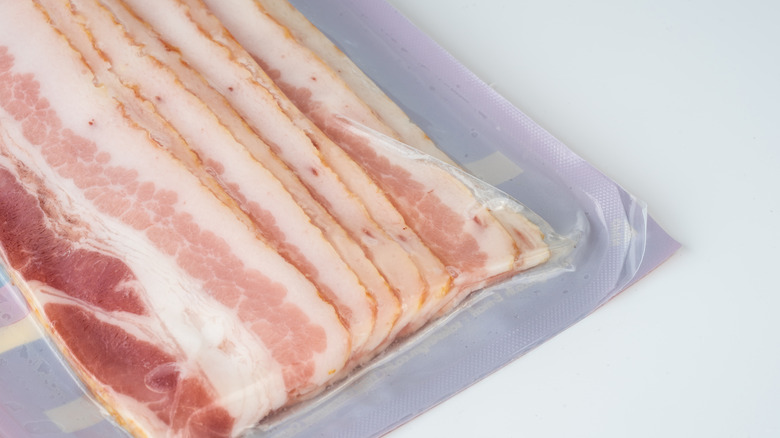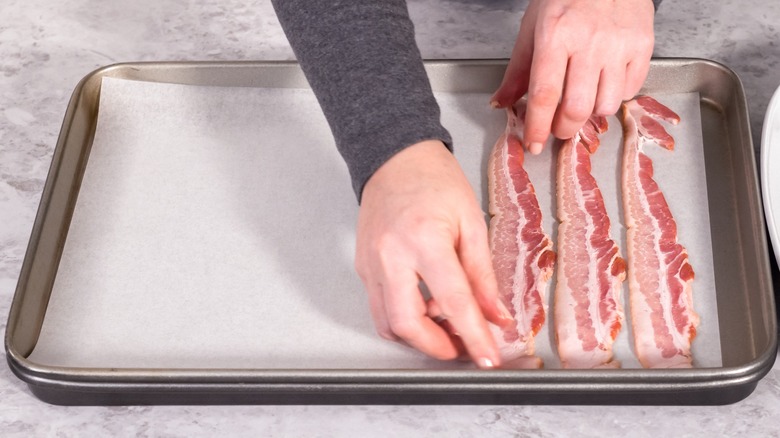15 Mistakes Everyone Makes When Cooking Bacon
There's nothing quite like the deliciously smoky, salty flavor of bacon. In fact, it's so beloved that astronauts have eaten it for breakfast on the surface of the moon. If that doesn't speak for its popularity, we don't know what does.
However, while few things can beat well-cooked, crispy bacon, there's nothing more disappointing than when it doesn't turn out just the way you like it. On the surface, bacon seems like it should be pretty straightforward to cook — but there are plenty of pitfalls that are easy to miss. These errors are surprisingly common, and falling for them may cause your rashers to end up rubbery or burned instead of crispy and fully cooked through. Fortunately, these mistakes are extremely easy to remedy once you're aware of them. Below, we've covered the most common missteps people make when cooking bacon, as well as the best ways to avoid them in the future.
Ignoring the different types of bacon
One of the biggest bacon-related errors you can make occurs before you even reach for your frying pan: choosing the wrong cuts. Most of us are familiar with the classic streaky bacon — thin, fatty strips that crisp up easily — but you're doing yourself a disservice by not trying the other styles available.
Back bacon, also known as Canadian bacon, is taken from the pork loin instead of the belly, so it tends to be leaner. It also usually comes in thicker cuts, perfect if you like your bacon a little bit chewy. Then, there's the British style of bacon which is cut from the belly and the loin, giving you the best of both. If you're planning on cutting your bacon into pieces for a soup or salad, for example, then pre-diced lardons are more convenient than having to cut up whole rashers. Lastly, you'll want to pay attention to how the bacon has been cured. All bacon has been cured, regardless of what some labels may tell you, but different methods, such as smoking, will give the bacon a different flavor.
Cooking bacon with oil
While most things we cook in a frying pan require fat — usually butter or oil — this isn't the case with bacon. Cuts of bacon already come with streaks of fat running through them and, when cooked in the right way, you shouldn't need to add any extra.
When heat is applied to the bacon, the fat melts in a process known as "rendering," turning into a liquid that can fry the meaty part of the rasher. Even Canadian bacon, the leanest type, should have enough fat in it to cook the pork without additional oil. By introducing more fat than necessary, your bacon is likely to end up greasy, which is not something we're usually aiming for. Although fattier bacon tends to turn out crispier than leaner bacon, too much oil may overcook the exterior, resulting in a burned texture and acrid flavor. If, for some reason, your bacon isn't producing enough fat, you can lightly grease your pan with oil, but the issue is more likely down to your cooking technique.
Using bacon straight from the fridge
While bacon should be stored in the refrigerator to keep it from spoiling, you shouldn't cook cold bacon before it's had time to warm up. In fact, this goes for pretty much every chilled, raw meat.
As we mentioned above, bacon cooks in its own fat. However, if the fat is too cold when you start the cooking process, it won't have enough time to fully render. This usually leads to one of two outcomes, neither of which is particularly appealing. First, the fat won't melt properly, so it will remain attached to the bacon with a chewy, rubbery texture. At the same time, if you cook the bacon long enough for the fat to fully render, the meaty part of the rasher will likely end up tough and overcooked. The trick is to simply remove your bacon from the fridge a little before you need to cook it. As bacon is pretty thin, it should only take about 15 minutes for it to reach a suitable temperature.
Preheating the pan
In many recipes, it's recommended to preheat your pan or oven to ensure food is cooked evenly all the way through. You'd be forgiven for assuming the same applies to bacon; however, in this case, the opposite is true.
Once again, this comes down to the bacon fat needing enough time to render. Throwing bacon into a hot pan will start cooking the meat instantly, but the fat won't get the chance to melt properly. Fat also tends to seize up when it's met with immediate, intense heat, so it's even less likely to render out completely. By starting with a cold pan, the fat will render slowly, giving it enough time to fully melt, resulting in perfectly cooked, crispy bacon without any soggy or rubbery sections. Plus, you're more likely to get hit with spitting hot fat by adding bacon to a preheated pan, which is a less-than-pleasant experience that should be avoided at all costs.
Using a heat that's too high
By now, you've probably gathered just how important temperatures are when it comes to bacon, but that leaves us with one more, crucial question. Your bacon is room temperature, and the pan is cold, but what cooking temperature should you be aiming for?
Ultimately, it depends on the thickness of the bacon cut, but as a rule of thumb, low and slow is the way to go. Your stove shouldn't be set to more than a medium-low heat, so again, the fat has time to render slowly without the meat cooking too quickly. Even thick-cut bacon is relatively thin, so it doesn't take much for it to start burning before it's ready. Instead of upping the temperature, you're better off increasing the cooking time. Generally, streaky bacon shouldn't take more than 7-10 minutes in the pan, but back bacon may take 10-12 minutes. This also depends on how crunchy you like your bacon, as cooking it for longer will give it more time to crisp up.
Not patting the bacon dry
If you do prefer your bacon crispy, or you find that it's coming out a little too chewy, the issue is likely excess moisture. Fortunately, the solution is remarkably straightforward.
Before you throw your bacon in the pan, start by gently patting it dry with some paper towels. The fat won't begin to render properly until any water has evaporated, so drying the bacon first is key to helping the process along. You may also want to keep those paper towels handy for after cooking. Often, you'll find your bacon is still coated in hot grease when it comes out of the pan, especially if you're using fattier cuts. Although you can wait for the grease to cool, you can speed things up by lining a plate with paper towels and laying your freshly cooked bacon on top. The paper towels will absorb the excess fat and, if you're careful, you can pat the tops dry too.
Overcrowding the pan
Regardless of how much you pat your bacon dry before cooking, there'll always be some moisture remaining. This moisture will evaporate away as steam, but only if you leave enough space in the pan.
Although it might be tempting to cram your pan with bacon, if the rashers are too close together, the steam will become trapped. With nowhere to go, the moisture can lead to soggy bacon that refuses to crisp up. It also affects the cooking temperatures, so there's a chance your bacon will heat unevenly, with some sections or pieces cooking faster than others. The only real solution is to be wary of how much bacon you're cooking at once. If you're using a frying pan, you may need to cook the bacon in batches, but you can transfer the cooked rashers to a preheated oven if you want to keep it warm. Just make sure you're practicing good food safety by ensuring the oven temperature is at least 135 degrees Fahrenheit if you're using it for hot holding.
Using the wrong type of frying pan
Regardless of your meat quality and cooking skills, perfectly cooked bacon relies on using the right tool for the job. In this case, we're talking about the type of pan you use for frying.
Although a non-stick frying pan will do the trick, it's ultimately unnecessary, because the fat should allow the bacon to release itself from the pan when cooked properly. The issue with stainless steel and copper pans is that they're a little too effective at conducting heat. We already touched on the importance of cooking bacon slowly, so if the pan heats up too quickly, you may not get the results you're looking for. The best type of frying pan for bacon is arguably cast iron, as it takes longer to warm up but retains heat extremely well. The bacon grease will also contribute to the seasoning of the pan, allowing it to build its own natural non-stick coating over time.
Flipping the bacon too soon or too often
If you want your bacon to be nice and crispy on both sides, you're going to want to flip it over partway through cooking. However, a common mistake is flipping the bacon before it's ready, or flipping it too frequently.
One of the reasons fried or baked food tastes so good is due to a chemical process known as the Maillard reaction. Without getting too technical, when heated, the sugars and amino acids in foods react with one another. This reaction is responsible for the irresistible flavors and aromas of browned food, as well as the rich coloring. That said, the process takes time, and it requires direct heat, which is why we flip the bacon. If the bacon is flipped too soon, the meat may have begun to cook, but you'll miss out on the added flavor, and some of the crispy texture. To avoid flavorless, rubbery bacon, wait until the rasher begins to curl from the heat, you can see the fat has melted, and the meat comes away easily from the pan. When timed correctly, you should only need to flip your bacon once.
Not adding water to the pan
If you're following all of the steps above and still having issues with unevenly cooked bacon that refuses to crisp up, there's one more cooking hack that's worth trying. Although, generally, we want our bacon to be as dry as possible before cooking, in this case, we're going to do the opposite.
As it turns out, you can avoid rubbery bacon by adding a few tablespoons of water to the frying pan. However, be careful not to completely cover the bacon, as we're not trying to boil it. Because the fat and the meat cook at different rates, adding water gives the fat even more time to render. It may take a couple of attempts to get right, but as long as you don't add too much water, it should all evaporate by the time your bacon is ready to eat. The best part is that this technique works for all types of bacon, regardless of how it's cured or how thick the cuts are.
Not reusing the leftover bacon grease
More often than not, when you've finished cooking bacon, you'll be left with a reasonable amount of grease left over. Now, while disposing of the grease won't impact the quality of your bacon, you're throwing out a versatile cooking ingredient that has the potential to truly elevate future dishes.
You can use bacon grease as a substitute in plenty of savory dishes that call for fat, imparting the food with a rich smoky, meaty flavor. With a smoke point of around 325 degrees Fahrenheit, you can cook with bacon grease at higher temperatures than you can with butter, although not as hot as olive or vegetable oil. This makes it an excellent option for slower-cooked foods, like caramelized onions. It also has a higher fat-to-water ratio than butter, which has its perks if you're baking with flour. More fat makes it harder for gluten to form, so if you use it to make savory biscuits, for example, you'll end up with a more tender crumb. To save the grease, start by skimming off any remnants of bacon. Let it cool — but not to the point it's solidified — carefully strain it into a wide-necked jar, and store it in the fridge until you're ready to use it.
Improperly disposing of unwanted grease
If you decide you don't want to keep any leftover bacon grease, you at least need to make sure you dispose of it correctly. While pouring it down the sink or garbage disposal might seem like the quickest and simplest option, the fat can play havoc with your plumbing.
When the bacon grease cools, it becomes solid again, meaning there's a chance it will block your pipes or garbage disposal. This can result in costly — and messy — issues that should be avoided at all costs. Instead, you should wait until the grease solidifies in the pan. When it's cool enough to touch, you can scrape it out with a spoon or paper towel, and throw it in the trash. If you're using the oven, line the catchment pan with aluminum foil, as this will save you cleaning it while also making it easier to get rid of the used fat. Alternatively, if the grease is still in liquid form, you can carefully pour it into a disposable container with a lid and dispose of the entire container.
Ignoring alternative methods for cooking bacon
While most people reach for the frying pan when cooking bacon, it's not the only way to get the job done. In fact, if you need to cook a lot of bacon at once, you're better off choosing your oven instead.
Start by laying out your bacon on a baking tray. To avoid excess grease, you can also place it on a rack to let the fat run off into a tray below. Like with the frying pan, you want to start with a cold oven, place the tray on a middle rack, and turn the heat up to 400 degrees Fahrenheit. After 10 minutes, flip the bacon once, and let it bake for another 10 minutes or until it reaches your desired doneness. As long as your oven doesn't have cold spots, your bacon will come out just as well as if you'd taken the frying approach. The baking method does take longer, but if you want to cut down on the cooking time, you can use the oven's broiler instead. However, be sure to keep a close eye on the bacon, as the broiling method uses high, direct heat, and can burn the meat if you're not careful.
Incorrectly storing opened bacon
Like any raw meat, bacon will start to turn once the packaging has been opened, so it needs to be stored properly if you don't plan on eating the whole pack at once. For starters, you need to make sure any unused bacon goes back into the fridge if you want to use it again later.
Aside from refrigeration, bacon is preserved better when it isn't in contact with air, which is why it usually comes vacuum-sealed in the supermarket. Unfortunately, most bacon packaging isn't resealable. Some manufacturers claim that the extra packaging costs just aren't worth it because people tend to cook the whole pack at once, but this isn't always the case. If you want your bacon to last as long as possible and — like the majority of people — you don't own a vacuum packing machine, the next best thing is a zipped plastic bag. Make sure you use a bag that's big enough to fit your bacon without smushing it, and be sure to press out as much air as you can before sealing.
Not lining your oven pan
As we covered earlier, using the oven to cook bacon comes with a few key benefits — not only can you make larger batches, but it tends to be a cleaner method, too. Using a rack is one option, but you might find better results putting the bacon straight onto the baking pan if you remember this important step.
By lining your oven pan with parchment paper, you'll avoid having to scrub it clean once your bacon's finished cooking. Additionally, because the meat is being heated from multiple directions, you shouldn't have to flip your bacon halfway through either. This means you won't have to open your oven during cooking, which can let heat escape and affect how evenly the bacon bakes. It also means you're less likely to get hit by any hot grease. Thanks to the non-stick nature of the parchment paper and the fat content of the bacon, your rashers should easily peel off the tray. Then, you can simply toss the used parchment paper in the trash, which saves time dishwashing and disposes of the leftover grease in an appropriate manner.

